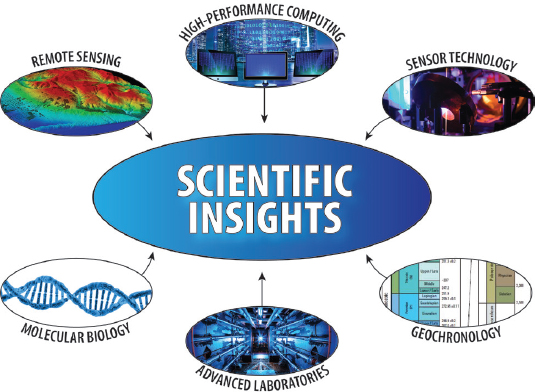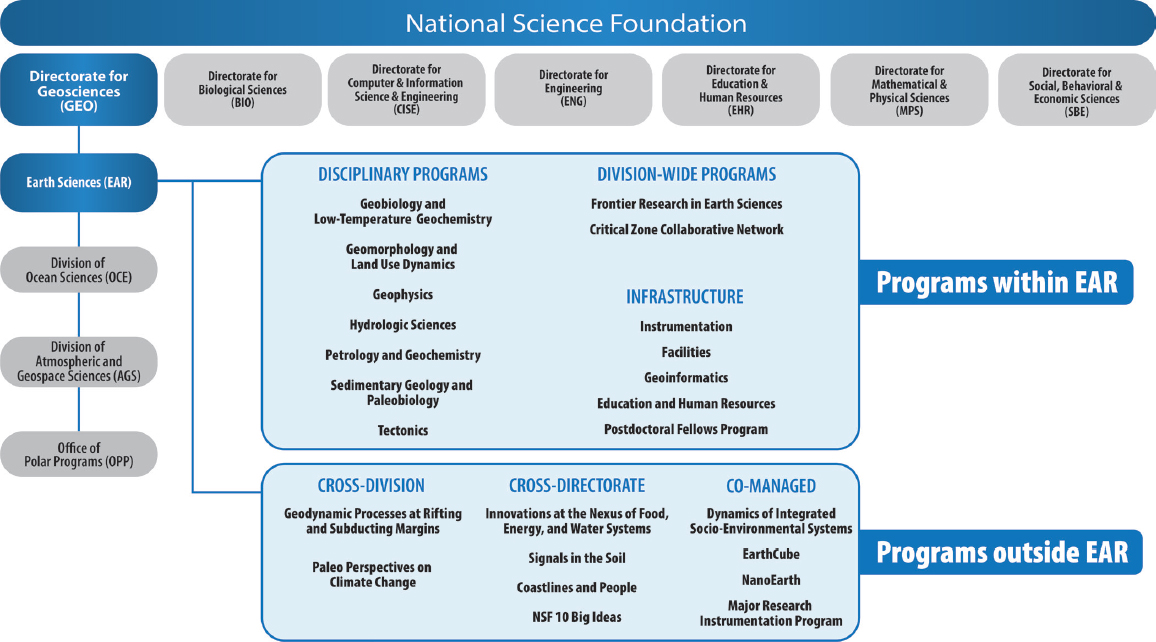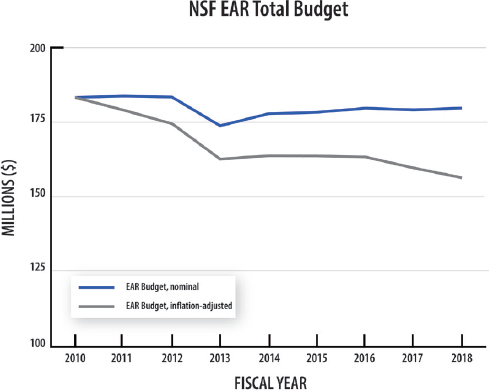1
Introduction
Earth’s surface, interior, oceans, atmosphere, cryosphere, and biosphere form a complex, interacting system connected by physical, chemical, and biological processes that operate over spatial scales from the atomic to the planetary and over temporal scales from milliseconds to billions of years. Apparent terra firma is in fact constantly changing: steadily through biological processes, chemical reactions, and physical erosion, and over geologic time as plate tectonics creates, deforms, and destroys Earth’s lithosphere; suddenly and catastrophically through large extraterrestrial impacts, glacial outburst floods, mega-tsunami, and flood basalt volcanism; and most recently through the actions of humans.
Earth’s geologic record reveals multiple and profound transformations that affect the planet’s character and habitability (see Figure 1-1). These include:
- Earth’s accretion and differentiation 4.5 billion years ago, which formed the iron-rich core and bulk silicate Earth;
- the subsequent development of the geodynamo in Earth’s liquid outer core, which generates the magnetic field and by doing so deflects plasma radiation from eroding the atmosphere and oceans;
- the emergence of plate tectonics (at an as-yet unknown time), which led to the differentiation of Earth’s crust and mantle;
- the emergence of life followed by the Great Oxidation Event, which permanently changed Earth’s surface chemistry 2.4 billion years ago and ultimately led to an increase in the anatomical and physiological diversity of life;
- states of Snowball Earth that sporadically encased the globe in ice, most recently 630 million years ago;
- the emplacement of large igneous provinces, for example, the Siberian Traps, which coincided with Earth’s most extreme known extinction event 252 million years ago;
- the demise of the dinosaurs in the end-Cretaceous extinction, whether triggered by the impact of a large extraterrestrial body and/or the massive Deccan Trap eruptions, 66 million years ago;
- the Paleocene-Eocene Thermal Maximum, when temperatures and atmospheric carbon spiked in an ice-free world 56 million years ago;
- the repeated ice ages of the past several million years that covered large continental landmasses with mile-thick ice as recently as 11,000 years ago; and
- the ongoing Anthropocene, in which humans have emerged as geologic agents.
Such events have profoundly transformed the Earth and underscore the fact that we live on a remarkable and dynamic planet.
“The present is the key to the past” is a fundamental tenet of Earth science that remains obvious and important. The converse is also true: the wide range of conditions represented in Earth’s past provides essential clues for understanding the Earth at present. Understanding Earth’s long history is also critical for the urgent task of anticipating Earth’s future. The committee chose Earth in Time as the subtitle of the report because it reflects the urgency of understanding Earth processes and how they affect habitability and expresses the importance of understanding how the Earth has evolved over geologic time.
That future is uncertain as humanity profoundly modifies the Earth system in ways that are consequential to the entwined fates of the natural world and civilization. The Earth is subject to a variety of hazards

that are far from understood but increasing in their impact as exposure to risk grows dramatically through urbanization. This is particularly true in hazard-prone areas such as the world’s coastal areas, seismically and volcanically active areas, and climatically vulnerable regions. This century will see Earth’s finite nature become more apparent as a growing population that relies on the availability of freshwater, soil, energy, and critical minerals will find these resource needs more difficult to address. A rapidly changing climate heightens these challenges and introduces new stresses stemming from sea-level rise, drought, extreme precipitation, intensifying storms and wildfires, and abruptly changing ecosystems.
It is the work of geoscientists to develop a comprehensive scientific understanding of the complex Earth system. The task is intrinsically interesting, and worth pursuing for that reason alone. It is made urgent by the need to understand how the Earth can continue to sustain civilization and the planet’s biodiversity. Each component—the atmosphere, hydrosphere, cryosphere, biosphere, and Earth’s surface and interior—is itself complex. Moreover, these components do not operate independently. Most of Earth’s interior is, and will remain, inaccessible to direct observation, such that knowledge of the deep subsurface must be inferred through imaging and laboratory and computational experiments. While more accessible, the shallow region of the terrestrial Earth, meters to tens of meters below the surface, is still poorly documented.
Novel sensor technologies, as well as new field and laboratory capabilities, are transforming observations from the atomic to the global scale (see Figure 1-2). Computer simulations are increasingly rapid and accurate and representative of Earth’s true multi-scale complexity. New field and laboratory capabilities are transforming observations from the atomic to the global scale. Breakthroughs in geochronology, geochemistry, molecular biology, and phylogenetics are revolutionizing the understanding of geological and geochemical processes. Recent advances in data science, such as machine learning, have the potential to extract new insights from large, high-dimensional datasets and simulations that would otherwise be elusive.
No less important in the understanding of Earth systems are conceptual breakthroughs. The plate tectonics revolution, for example, suddenly brought order to a disparate array of previously puzzling and seemingly unrelated observations. The mega-tsunami that have repeatedly occurred in Hawaii and other volcanic islands through sudden collapse of their flanks, the for-

mation of eastern Washington’s Channeled Scablands by major Pleistocene flooding events, and the realization that the modern structure of the Chesapeake Bay is profoundly influenced by an extraterrestrial impact 35 million years ago are all examples of how puzzling observations have come to be understood through conceptual breakthroughs. Research breakthroughs, by nature, are difficult to anticipate; however, this report highlights frontier research opportunities that are poised to accelerate understanding of the geosystem and that the National Science Foundation’s (NSF’s) Division of Earth Sciences (EAR), which has as its research focus Earth’s surface and interior, may wish to pursue.
NSF DIRECTORATE FOR GEOSCIENCES AND DIVISION OF EARTH SCIENCES
EAR supports research addressing “the structure, composition, and evolution of the Earth, the life it supports, and the processes that govern the formation and behavior of the Earth’s materials.”1 The divisions within NSF’s Directorate for Geosciences (GEO) largely align with the spheres as defined in an integrated Earth systems context (atmosphere, ocean, cryosphere, and Earth’s surface and interior; see Figure 1-3). The EAR research portfolio includes investigator-based research projects, multi-investigator programs, investments in facilities, and GEO and cross-directorate initiatives. EAR also collaborates with other units within NSF, as well as with other federal agencies and international entities, to provide essential infrastructure capabilities to Earth scientists. EAR’s basic research programs also help federal mission agencies improve the use of applied science to serve societal needs.
EAR’s organizational structure consists of two sections: Disciplinary Programs and Integrative Activities. Disciplinary Programs (often called the “core programs”) encompasses Geobiology and Low-Temperature Geochemistry, Geomorphology and Land Use Dynamics, Geophysics, Hydrologic Sciences, Petrology and Geochemistry, Sedimentary Geology and Paleobiology, and Tectonics. Integrative Activities includes EAR Education and Human Resources, Earth Sciences Instrumentation and Facilities, Frontier Research in Earth Sciences, and NSF Earth Sciences Postdoctoral Fellowships. EAR disciplinary programs leverage significant infrastructure capabilities developed and operated by other federal agencies.

___________________
1 See https://www.nsf.gov/geo/ear/about.jsp (accessed January 29, 2020).
In addition, there are cross-cutting programs in which EAR participates with other divisions and/or directorates. These include cyberinfrastructure and data management programs such as Cyberinfrastructure of Sustained Scientific Innovation, Geoinformatics, and Advancing Digitization of Biodiversity Collections; education programs such as Improving Undergraduate STEM Education: Pathways into Geoscience; Partnerships between Science and Engineering Fields and the NSF TRIPODS Institutes; and interdisciplinary and convergent programs such as Signals in the Soil, Critical Zone Collaborative Network, Critical Aspects of Sustainability, Origin of Life, and Paleo Perspectives on Climate Change. Since 2017, NSF has been building a foundation for U.S. research leadership through the 10 Big Ideas,2 which encompasses a combination of research and pilot activities. In 2019, for example, NSF planned to invest $30 million per Big Idea.
EAR’s annual budget has been roughly constant since fiscal year (FY) 2010, varying from a low of $173 million to a high of almost $184 million (see Figure 1-4a). While its current budget is approximately half that of the Division of Ocean Sciences (OCE) and about 70% of the Division of Atmospheric and Geospace Sciences (AGS) (see Figure 1-4a), the amount of funding that EAR devotes to research (see Figure 1-4b) is approximately equal to AGS and about 70% of OCE’s funding. EAR’s investment in infrastructure has been fairly consistent since FY2010 (see Figure 1-4c), accounting for 31-34% of the total yearly budget. Due to inflation, EAR’s level budget necessarily supports less research today than in past years (see Figure 1-5). A decade of level-funded budgets creates challenges not only for EAR to continue to support its current successful research programs, but to consider new opportunities for programs and infrastructure.
STUDY ORIGIN
EAR relies on community input to develop long-term strategies for research priorities. From time to time, EAR examines its portfolio to evaluate the kinds of research, programs, and facilities to prioritize for funding opportunities for the research community. This prioritization of research and associated infrastructure is also important for workforce development to help train the next generation of Earth scientists. In 2018, EAR asked the National Academies of Sciences,

___________________
2 See https://www.nsf.gov/news/special_reports/big_ideas (accessed March 23, 2020).

Engineering, and Medicine’s Board on Earth Sciences and Resources to undertake a decadal survey that provides guidance on future Earth science research priorities and supporting facilities and infrastructure. The request was initiated by Carol Frost, EAR Division Director at the time. The full Statement of Task is provided in Box 1-1.
THE COMMITTEE PROCESS
The Committee on Catalyzing Opportunities for Research in the Earth Sciences (CORES): A Decadal Survey for NSF’s Division of Earth Sciences was convened by the National Academies at the request of NSF. In response to concerns about the initial composition of the provisional committee, three additional members were added after the first committee meeting. The final committee consisted of 20 members, working on a volunteer basis from November 2018 through April 2020, with expertise in a broad range of Earth science as well as geographic diversity, career-stage breadth, and gender balance. Committee member and staff biographies are provided in Appendix A.
The committee felt strongly that active participation from the Earth sciences community was essential to the study process. It organized listening sessions at major conferences, meetings and interviews with early- and mid-career scientists, presentations at community meetings, and an online questionnaire that called
on the Earth sciences community to offer individual views on future research priorities (see Appendix B for the questionnaire). There were almost 350 responses to the online questionnaire, which provided robust community input.
The committee held five meetings with public information-gathering sessions, a workshop on management models for future seismological and geodetic facility capabilities, and two meetings in closed session to develop this report. Public meeting agendas are listed in Appendix C.
PREVIOUS DECADAL STUDIES
This study follows two previous reports that the National Research Council produced for EAR: Basic Research Opportunities in Earth Science (BROES) and New Research Opportunities in the Earth Sciences (NROES) (NRC, 2001, 2012). The recommendations of these reports are summarized in Box 1-2. As a prologue to this study, we briefly review the legacy of these community-driven, forward-looking reports on priorities for Earth science research.
BROES and NROES both had lasting impact. The BROES recommendation for multidisciplinary studies of the critical zone led to the establishment of a network of nine critical zone observatories that serve as a platform for research at the catchment/watershed scale and focus on chemical, physical, and biological processes that connect life, water, climate, and bedrock in the dynamic skin of the Earth. The BROES endorsement of the EarthScope initiative was acted on, and all three components of EarthScope—the geodetic Plate Boundary Observatory, the USArray seismological capability, and the San Andreas Fault Observatory at Depth—were successfully completed, providing new insights into the deformation and architecture of the North American continent and on the nature and properties of the San Andreas Fault at depth. Another lasting impact stemming from the BROES report was the establishment of EAR’s Geobiology and Low-Temperature Geochemistry program.
BROES was published in 2001, at a time when the NSF budget was expected to grow. NROES, on the other hand, was published in 2012, at a time when the NSF budget was flat. Despite these headwinds, the NROES recommendations led to the transformation of the Continental Dynamics program into Integrated Earth Systems,3 which supported multidisciplinary research
___________________
3 The Integrated Earth Systems program recently evolved into Frontier Research in Earth Sciences. See https://www.nsf.gov/funding/pgm_summ.jsp?pims_id=504833 (accessed March 31, 2020).
from Earth’s core to the critical zone at a budgetary scale larger than that of a typical disciplinary program. The NROES recommendations also led NSF to increase technician support, addressing a long-standing research sustainability issue that continues to be a concern of the EAR-supported community.
These examples illustrate specific, tangible impacts of the BROES and NROES reports; however, both reports emphasized and began their recommendations with an appeal to the importance of continuing support for individual investigator-driven science. A good idea or discovery can rapidly advance a field in an unexpected direction, with impacts that could not have been anticipated. For example, GPS data from the Plate Boundary Observatory were used for the unexpected purpose of tracking soil moisture content. The BROES report could not foresee the discovery of a broad spectrum of deformation events, including tremor and slow slip. This spectrum of deformation events featured prominently in the NROES report; however, NROES in turn did not predict more recent developments, such as the accelerating impact of data science in the study of Earth science problems. Future decadal studies will no doubt be able to draw similar conclusions about this report. Such important but unanticipated developments attest to the continuing need for EAR to support investigator-driven science.
We also note that basic research in Earth science can have profound and unexpected impacts. A compelling example stems from the quest to determine the age of the Earth, which was driven by curiosity rather than strategic objectives, through lead-lead isotope dating. Lead-lead dating (Patterson, 1956) requires extremely clean laboratory conditions, which led to the recognition of ubiquitous industrial lead contamination (Patterson, 1965). This recognition motivated increased research focus on the human-health effects of environmental lead, and culminated in the banning of lead from household paint, gasoline, and food containers (NRC, 1980). A more recent example concerns the increasing appreciation for the role of clay minerals in fighting bacteria and other health hazards, catalyzing the emergent, interdisciplinary field of geohealth, including medical mineralogy and geochemistry. These examples demonstrate that curiosity-driven research can have far-reaching, unanticipated impacts and further attests to the continuing need for EAR to maintain a diverse research portfolio that includes research with no immediate societal relevance.
Earth science research is essential to understanding how we got here and is critical to anticipating Earth’s future. This report covers many ways that NSF can maintain and strengthen programs to enable a creative and diverse population of geoscientists who will strive to attain a new level of understanding of Earth’s materials, processes, and history, now and in future generations. The committee offers its recommendations with that goal in mind. The report outline is as follows: Science Priority Questions (Chapter 2), Infrastructure and Facilities (Chapter 3), Partnerships (Chapter 4), and A Decadal Vision for Earth Sciences (Chapter 5).
REFERENCES
NRC (National Research Council). 1980. Lead in the Human Environment. Washington, DC: National Academy of Sciences.
NRC. 2001. Basic Research Opportunities in Earth Science. Washington, DC: National Academy Press. https://doi.org/10.17226/9981.
NRC. 2012. New Research Opportunities in the Earth Sciences. Washington, DC: The National Academies Press. https://doi.org/10.17226/13236.
Patterson, C. C. 1956. Age of meteorites and the Earth. Geochimica et Cosmochimica Acta 10:230-237.
Patterson, C. C. 1965. Contaminated and natural lead environments of man. Archives of Environmental Health 11:344-360.








